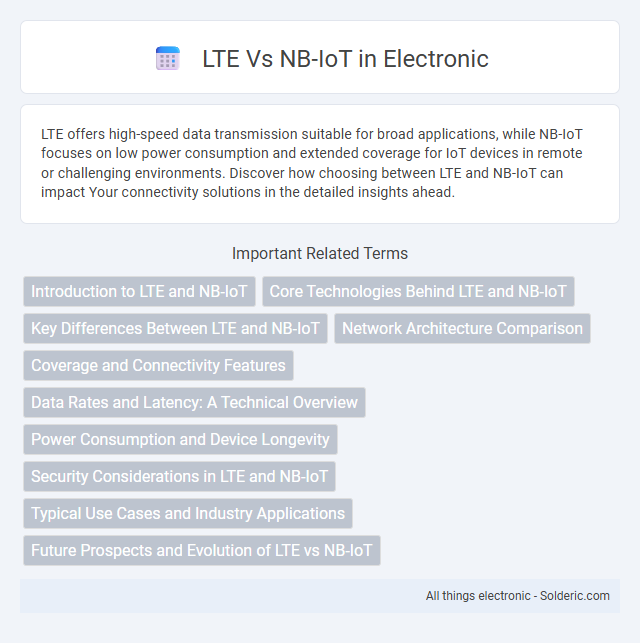LTE offers high-speed data transmission suitable for broad applications, while NB-IoT focuses on low power consumption and extended coverage for IoT devices in remote or challenging environments. Discover how choosing between LTE and NB-IoT can impact Your connectivity solutions in the detailed insights ahead.
Comparison Table
| Feature | LTE | NB-IoT |
|---|---|---|
| Technology Type | 4G Broadband Cellular | Low Power Wide Area Network (LPWAN) |
| Bandwidth | 1.4 MHz to 20 MHz | 180 kHz |
| Data Rate | Up to 100 Mbps (DL) | Up to 250 kbps |
| Power Consumption | High (designed for continuous data) | Ultra Low (optimized for IoT) |
| Coverage | Urban and suburban | Extended deep indoor and rural |
| Latency | Low (~10-50 ms) | High (~1.6-10 s) |
| Connection Density | Medium (thousands per cell) | High (up to 50,000 devices per cell) |
| Use Cases | Mobile broadband, voice, video | Smart meters, asset tracking, sensors |
Introduction to LTE and NB-IoT
LTE (Long Term Evolution) is a high-speed wireless communication standard designed for mobile broadband and supports a wide range of applications with high data rates and low latency. NB-IoT (Narrowband IoT) is a low-power wide-area network (LPWAN) technology optimized for IoT devices requiring extended coverage, low throughput, and long battery life. Both technologies complement each other, with LTE serving high-data applications and NB-IoT targeting massive IoT deployments with energy efficiency and deep indoor penetration.
Core Technologies Behind LTE and NB-IoT
LTE relies on OFDMA and SC-FDMA for efficient spectrum utilization and supports high data rates through MIMO and carrier aggregation technologies. NB-IoT employs narrowband single-carrier FDMA in the uplink and OFDMA in the downlink to optimize power consumption and coverage for low-bandwidth IoT applications. Both LTE and NB-IoT integrate with the LTE EPC (Evolved Packet Core), but NB-IoT features extended coverage and simplified device architecture tailored for massive machine-type communications.
Key Differences Between LTE and NB-IoT
LTE offers high data rates suitable for multimedia applications, while NB-IoT is designed for low power, long-range communication with minimal data throughput. NB-IoT supports massive device connectivity in IoT deployments with enhanced indoor coverage and extended battery life compared to LTE. The narrow bandwidth of NB-IoT reduces complexity and cost, making it ideal for sensor networks, whereas LTE handles broader bandwidth for diverse mobile services.
Network Architecture Comparison
LTE employs a complex, high-capacity network architecture designed for broadband connectivity with extensive base station infrastructure, supporting high data rates and low latency. In contrast, NB-IoT features a simplified network architecture embedded within existing LTE frameworks, optimized for low power, deep coverage, and massive device connectivity with reduced bandwidth. The distinct architectural design enables LTE to handle high-throughput applications, while NB-IoT excels in efficient, low-cost IoT deployments with extended battery life.
Coverage and Connectivity Features
LTE provides broader bandwidth and higher data rates, suitable for applications requiring continuous connectivity and real-time data transmission. NB-IoT excels in deep indoor and underground coverage with low power consumption, designed for massive IoT deployments where extended battery life and reliable signal penetration are critical. Coverage enhancements in NB-IoT enable connectivity in challenging environments unreachable by conventional LTE networks.
Data Rates and Latency: A Technical Overview
LTE offers data rates up to 300 Mbps with latency typically around 10-50 milliseconds, making it suitable for high-throughput and low-latency applications. NB-IoT provides significantly lower data rates, approximately 20-250 kbps, with higher latency ranging from 1 to 10 seconds, optimized for low-power, wide-area IoT devices. The trade-off between high data throughput in LTE and energy-efficient, prolonged connectivity in NB-IoT defines their distinct technical applications in wireless communication.
Power Consumption and Device Longevity
NB-IoT technology significantly reduces power consumption compared to LTE by utilizing narrower bandwidths and optimized protocols, enabling devices to operate for up to 10 years on a single battery. This energy efficiency makes NB-IoT ideal for applications requiring long device longevity and infrequent data transmissions. Your choice between LTE and NB-IoT should consider how critical extended battery life is to your IoT deployment.
Security Considerations in LTE and NB-IoT
LTE employs robust security protocols like EPS-AKA for mutual authentication and encryption, ensuring strong protection against eavesdropping and attacks. NB-IoT, designed for low power and extended coverage, uses simplified yet effective security mechanisms derived from LTE standards, balancing security with device constraints. Your choice between LTE and NB-IoT should consider these differences, as NB-IoT may have limitations in handling complex security threats compared to LTE.
Typical Use Cases and Industry Applications
LTE excels in high-speed mobile broadband, video streaming, and real-time communication applications, making it ideal for smartphones, tablets, and connected vehicles in industries like telecommunications and automotive. NB-IoT targets low-power, wide-area use cases with massive device connectivity, such as smart metering, environmental monitoring, and asset tracking, serving sectors like utilities, agriculture, and logistics. Both technologies complement each other by addressing different performance and energy efficiency requirements in the IoT ecosystem.
Future Prospects and Evolution of LTE vs NB-IoT
LTE continues to evolve with 5G integration, emphasizing enhanced mobile broadband and ultra-reliable low-latency communication, which supports a broad range of applications from smart cities to autonomous vehicles. NB-IoT, designed for massive machine-type communications, focuses on deep coverage, low power consumption, and cost efficiency, positioning it as the leading technology for large-scale IoT deployments such as smart metering and asset tracking. Future prospects indicate LTE will serve as a robust backbone for high-speed, latency-sensitive use cases, while NB-IoT will drive the expansion of energy-efficient, wide-area IoT ecosystems.
LTE vs NB-IoT Infographic

 solderic.com
solderic.com